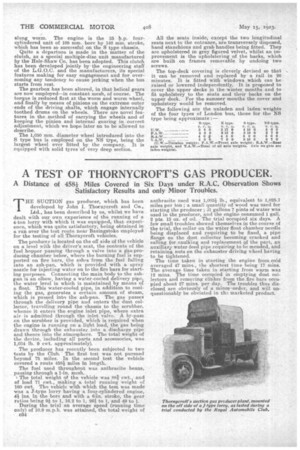A TEST OF THORNYCROFTS GAS PRODUCER.
Page 20

If you've noticed an error in this article please click here to report it so we can fix it.
A Distance of 4581 Miles Covered in Six Days under R.A.C. Observation Shows Satisfactory Results and only Minor Troubles.
THE SUCTION gas producer, which has been dev-eloped by John 1. Thornycroft and Co., Ltd., has been described ls1 us, whilst we have dealt With our own experience of the running of a 4-ton lorry with which it was equipped, that experience, which was quite satisfactory, being obtained in a run over the test route near Basingstoke employed for the testing of all Thornycroft vehicles.
The producer is located on the off side of the vehicle on a level with the driver's seat, the contents of the fuel hopper passing through a valve into a ggs-prodiming chamber below, where the burning fuel is supported on fire bars, the ashes from the fuel falling into an ash-pans whieh is provided with a spray nozzle for injecting water on to the fire bars for starting purposes. Connecting the main body to the ashpan is an elbow, having a water-cooled delivery pipe, the water level in which is maintained by 1110.1.118 of a float. This water-cooled pipe, in addition to coole ing the gas, generates a certain amount of steam, which is passed into the ash-pan. The gas passes through the delivery pipe and enters the dust collector, travelling round the chassis to the scrubber, whence it enters the engine inlet pipe, where extra air is admitted through the inlet valve. A by-pass on the, scrubber is provided, Which is required when the engine is running on a light load, the gas being drawn through the exhauster into a discharge pipe and thence into the atmosphere. The total weight of the device, including all parts and accessories, was 1,034 lb. 9 cwt. approximately).
The producer has recently been subjected to two tests by the Club. The first test was not pursued beyond 75 miles. In the second test the vehicle covered a route 4581miles in length.
The fuel used throughout was anthracite beans, passing through a 1-in. mesh.
The total weight of the vehicle was 84 cwt.., and of load 71 cwt., making a total running weight of 160 cwt. The. vehicle with which the test was made was a J-type lorry having a four-eylindered engine, 4i• ins, in the bore and with a 6-in, stroke, the gear ratios being 9i to 1, 16.2 to 1, 261 to 1, and 49 to 1.
During the trial an average speed (running time only) of 10.9 m.p.h. was attained, the total weight of anthracite used waS 1,0031 lb., equivalent to 1,025.7 miles per ton ; a small quantity of wood was used for Starting the producer ; 31 gallons 7 pints of water was used in the producer, and the engine consumed 1 gall. 2 pts. 13 oz. of oil. The trial occupied six days. A few small troubles showed themselves in the course of the trial, the collar on the water float chamber needle being displaced and requiring to be fixed, a pipe flange on the dust collector becoming cracked and calling for caulking and replacement of the part, an auxiliate, water-feed pipe requiring to be mended, and retaining nuts on the exhauster driving wheel having to be tightened. The time taken in starting the engine from cold averaged 47 mins., the shortest time being 17 mins. The average time taken in starting from warm was 12 mins. The time occupied in emptying dust collectors and removing clinker from the fire bars occupied about 27 mins. per day. The troubles thus disclosed are obviously of a ininar.order, and will unquestionably be obviated in ths marketed product.






























